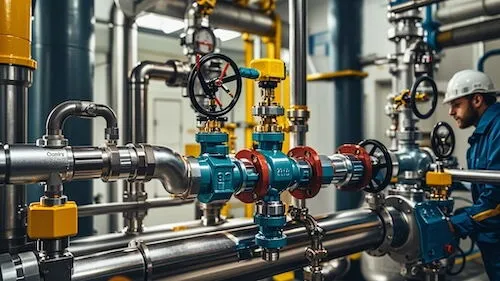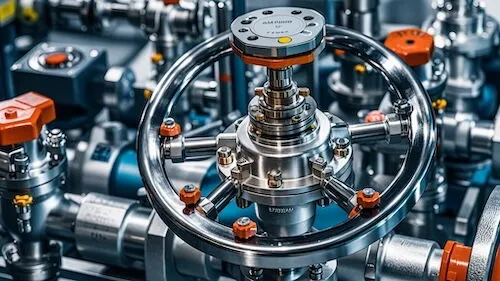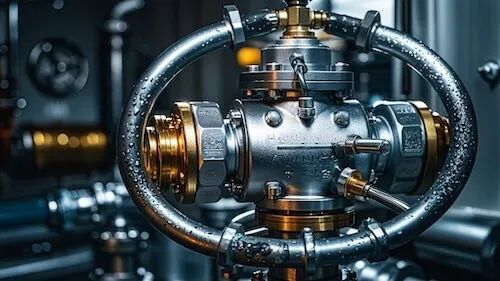Hydrogen Valve Testing
On this page
6.1 General requirements
Hydrogen valves should be subjected to a 150% liquid pressure test and a 100% gas leakage test at the rated pressure of the components. Valves used in low-temperature environments, such as liquid hydrogen and hydrogen propellants, should be subjected to low-temperature performance tests.6.2 Test conditions
The tested valves can be brand-new valves of the same series and sizes. Three representative valves, with the smallest, medium, and largest diameters, are selected for testing.6.2.1 Test pressure
The test pressure is the pressure rating of the valve material at 20°C. When conducting low-temperature performance tests, the test pressure remains the pressure rating of the valve material at 20°C. When the operating pressure of the valve in the hydrogen system is specified, the pressure value of the hydrogen system can be used as the test pressure.6.2.2 Test temperature
Normal test temperature: Refers to the test at room temperature of 20°C ± 5°C. Specified test temperature: The valves for gas filling stations are tested at -40°C (+0°C, -3°C) and 85°C (+3°C, -0°C). If the operating temperature range is specified, the test temperature is the lowest and highest temperatures of the range. Low-temperature test temperature: Valves used in low-temperature environments should be tested at this low temperature.
6.2.3 Test media
Tap water: For conventional shell strength tests and high-pressure seal tests.Air: After the water pressure shell strength test is passed, the gas shell strength test and gas high-pressure seal test are carried out.
Hydrogen: Pressure cycle testing of hydrogen filling station valves.
6.2.4 Test time
The test pressure holding time is twice the duration specified in GB/T 26480.6.3 Hydrogen pressure cycle testing
The valve should withstand 102,000 hydrogen pressure cycles without damage or leakage. It is acceptable to replace the valve seal every 16,000 cycles. The valve should be in the open position, and the cycle pressure should vary between less than 5% of the rated pressure and the rated pressure of the component (+3%, -0%) within a cycle time of no less than 6 seconds (10 times per minute). 100,000 cycles should be completed at room temperature, and 1,000 cycles should be completed at the highest and lowest temperatures in other environments.6.4 Leakage
6.4.1 General requirements
Before adjustment, purge the valve with nitrogen and then seal it at approximately 30% of the valve's rated pressure. The test should be carried out for 1 minute at two temperature conditions: -40°C (+0°C, -3°C) and 85°C (+3°C, -0°C). There should be no bubbles, or a hydrogen leakage rate of less than 10 cm³/h (normal).6.4.2 External leakage test
The valve under test and the gas under test (hydrogen) should be kept at the required test temperature for 1 hour before and during the test. The test pressure should be at least 100% of the component's rated pressure. The leakage rate should be measured using a flow measurement device.
6.4.3 Internal leakage test
The internal leakage test is only applicable to the cut-off valve, testing the pressure sealing performance of the valve seat. Connect the inlet and outlet ends of the valve (if applicable) to appropriate matching parts, and connect the outlet end of the valve to the flow measurement device in the open state. Use the flow measurement device to measure the leakage rate. The valve under test and the gas under test (hydrogen) should be kept at the required test temperature for 1 hour before and during the test. The pressure used for high-pressure tests should be at least 100% of the component's rated pressure. The pressure used for low-pressure tests should be 2.5% or less of the component's rated pressure.6.5 System Failure Pressure Cycle
In the event of a system failure, the valve should withstand the expected generated pressure. This test can only be performed at room temperature, and the test medium should be hydrogen. The inlet of the valve should be connected to a pressure source that can provide the necessary test with the outlet closed, following the test method of the valve hydrogen cycle test. The cycle should be between 5% and 110% of the component's rated pressure, and at least 110% of the component's rated pressure (+3%, -0%) within a period of no less than 6 seconds (10 times per minute).6.6 Pressure test
The test medium should be liquid. When the valve is in the open state, the pressure should be slowly increased to 150% of the component's rated pressure and maintained at this pressure for 10 minutes. The valve should not exhibit any leakage.
6.7 Water Pressure Strength Destructive Test
This test is carried out after passing the 6.6 pressure test. The test method is destructive and is carried out at room temperature. The valve tested using this method shall not be used for any further testing or put into use. The test pressure is 2.4 times the valve's pressure rating at room temperature. The valve should not break under this test pressure. If the valve leaks during the process of pressurizing to 2.4 times the pressure rating, it cannot be considered a failure as long as the pressure point at which the leakage begins exceeds 1.5 times the pressure rating and subsequently reaches 2.4 times the pressure rating.6.8 Over-torque Test
When the valve is installed on a threaded assembly or pipeline, it should withstand a torque value of 1.5 times the rated value of the measured pressure, and the valve should not deform, break, or leak. For threaded valves, the torque application time is 15 minutes. Then, the valve is disassembled and checked for deformation or damage. The valve is also subjected to the leakage test specified in 6.4.6.9 Bending Moment Test
The valve bending moment test refers to the test method "5.9 Bending Moment Test" in ISO 19880-3.6.10 Non-Metallic Material Test
When non-metallic materials such as resin or rubber come into contact with high-pressure hydrogen, the hydrogen will penetrate into the micropores of the material. When high-pressure hydrogen drops rapidly in a short period, the hydrogen that has entered the material will not be released in time, causing the material to bubble or rupture. To evaluate the effect of a rapid pressure drop on non-metallic materials, the following tests should be performed:(1) The valve outlet should be sealed, and the inlet connected to the high-pressure hydrogen interface.
(2) At room temperature, hydrogen should be added to 100% of the valve's pressure rating for at least 70 hours.
(3) The test pressure should then be rapidly reduced to atmospheric pressure.
(4) The valve sealing test should comply with the provisions of section 6.4.
6.11 Hydrogen Valve Low-temperature Test
The valve should be tested for performance at the specified low-temperature working environment. The following requirements apply to low-temperature valves at hydrogen filling stations in the absence of specific requirements:- The valve should be fed with pre-cooled hydrogen at a flow rate of 30 gs at -40°C (±3°C) for at least 3 minutes.
- For valves with ports facing the atmosphere or external moving parts, the test should be performed at 90% relative humidity under ambient conditions.
- After being kept at room temperature for 2 minutes, the valve should be depressurized and then re-pressurized. This test should be repeated 10 times.




